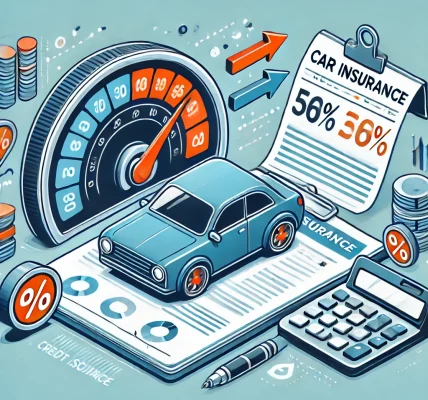Car insurance premiums vary from person to person, even for similar vehicles and coverage plans. Insurance companies use multiple factors to determine how much you will pay for coverage. Understanding these factors can help you make informed decisions and possibly lower your insurance costs.
This guide explores the key elements that influence car insurance rates in [Your Country] and provides actionable tips to manage your premium effectively.
1. Driving Record and History
Your driving history is one of the most significant factors in determining your insurance premium. Insurers assess your past behavior on the road to predict future risks.
Key Considerations:
- Traffic Violations: Speeding tickets, reckless driving, and other violations can increase your premium.
- Accident History: A record of at-fault accidents typically leads to higher insurance costs.
- Claims History: Frequent insurance claims may signal a high-risk driver, resulting in increased premiums.
How to Lower Your Rates:
- Follow traffic laws and drive cautiously.
- Take defensive driving courses to qualify for discounts.
- Maintain a clean driving record to earn a no-claims bonus.
2. Age and Driving Experience
Insurance providers consider your age and driving experience when calculating your premium. Younger and inexperienced drivers often face higher rates due to a perceived higher risk of accidents.
Typical Trends:
- Young Drivers (Under 25): Higher premiums due to inexperience and statistically higher accident rates.
- Middle-Aged Drivers (25-60): Lower premiums as they are considered experienced and responsible.
- Senior Drivers (Over 60): Rates may rise due to slower reaction times and health concerns.
Ways to Reduce Costs:
- Young drivers can take driver education courses to qualify for discounts.
- Consider being added as a secondary driver on a parent’s policy.
- Maintain a clean driving record to benefit from lower premiums over time.
3. Vehicle Type, Model, and Age
The car you drive has a direct impact on your insurance premium. Insurers assess the risk associated with your vehicle based on factors like safety ratings, repair costs, and theft rates.
Factors That Increase Premiums:
- Luxury or high-performance cars with expensive parts and higher repair costs.
- Vehicles with a high theft rate.
- Older cars that lack modern safety features.
Factors That Lower Premiums:
- Cars with high safety ratings and modern driver-assist technologies.
- Vehicles equipped with anti-theft devices and tracking systems.
- Economical cars with lower repair costs.
4. Location and Usage of the Vehicle
Where you live and how you use your car significantly impact your insurance rates.
Key Location-Based Factors:
- Urban vs. Rural: City dwellers often pay more due to higher traffic congestion, theft rates, and accident frequency.
- State or Region Regulations: Some states or regions have different insurance regulations that affect pricing.
Vehicle Usage Factors:
- Daily Commute: Longer commutes increase the likelihood of accidents, raising premiums.
- Occasional Use: If you drive less, you may qualify for a low-mileage discount.
- Rideshare or Commercial Use: Using your car for business purposes can increase premiums.
5. Coverage Options and Deductibles
The level of coverage you choose and your deductible amount affect your insurance costs.
Types of Coverage:
- Liability Coverage: Covers damages to others in an accident and is often legally required.
- Comprehensive Coverage: Protects against theft, natural disasters, and other non-collision incidents.
- Collision Coverage: Covers repair costs after an accident.
How Deductibles Impact Premiums:
- A higher deductible lowers your premium but increases out-of-pocket expenses in case of a claim.
- A lower deductible raises your premium but reduces what you pay in a claim.
6. Credit Score and Financial History
In some countries, insurance companies use credit scores to assess financial responsibility. A higher credit score can lead to lower insurance premiums.
Ways to Improve Your Score:
- Pay bills on time and reduce outstanding debt.
- Avoid applying for multiple credit lines in a short period.
- Regularly check your credit report for errors and correct them.
7. Gender and Marital Status
Statistical data may influence rates based on gender and marital status.
General Trends:
- Men under 25 may face higher premiums due to higher accident rates.
- Married individuals may receive discounts as they are considered more responsible drivers.
8. Annual Mileage
The more you drive, the higher your risk of an accident, leading to increased insurance costs.
How to Reduce Your Mileage:
- Use public transport or carpool when possible.
- Consider telecommuting to reduce daily commuting mileage.
- Enroll in a pay-as-you-drive insurance plan if available.
9. Loyalty and Discounts
Insurance companies often provide discounts for policyholders who meet certain criteria.
Common Discounts:
- No-Claims Discount: For drivers with a clean claims history.
- Multi-Policy Discount: Bundling car and home insurance can lower rates.
- Safe Driver Discount: Installing safety features or taking defensive driving courses can help.
10. Claims History
Frequent claims, even for minor incidents, can raise your insurance premium.
How to Maintain a Favorable Claims Record:
- Only file claims when necessary.
- Consider paying for minor repairs out-of-pocket.
- Opt for policies with a claim forgiveness feature if available.
Final Thoughts
Understanding the factors that affect car insurance rates can help you make informed decisions and potentially lower your premium. By maintaining a clean driving record, choosing the right vehicle, and exploring available discounts, you can optimize your insurance costs without compromising necessary coverage.
Always review your policy annually and compare quotes to ensure you’re getting the best deal. If you’re unsure about specific terms, consult a licensed insurance professional to make the best choices for your needs.



